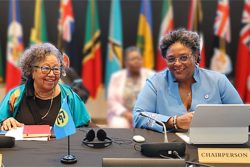Guyana achieved a historic milestone on December 1st when it became the first country to be issued carbon credits under the new high-integrity carbon standard ART (Architecture for REDD+ Transactions) and this has been lauded by Norway.
Guyana was issued 33.47 million forest carbon credits for preventing and reducing deforestation and forest degradation in the period 2016-2020. The credits have been verified by a third-party against ART’s robust environmental and social requirements. The announcement marks an important step for how tropical forest countries can sell high-integrity carbon credits for preventing and reducing deforestation and forest degradation.
“I congratulate Guyana on being the first country to issue forest carbon credits certified by ART, paving the way for many others to come. This marks a breakthrough for the emergence of a high-quality global carbon market to protect tropical forests”, said Espen Barth-Eide, Norway’s Minister of Climate and Environment in a statement. Guyana is the first country to conclude the ART process out of 15 jurisdictions that have so far entered the ART pipeline.
Norway and Guyana have collaborated on green development and forest conservation in Guyana since 2009. In this period, Guyana successfully maintained one of the world’s lowest deforestation rates. Norway’s support to Guyana adds up to approximately USD 220 mill (NOK 1.5 billion at the time) in total for maintaining low deforestation rate. The funding provided support to Guyana’s Low Carbon Development Strategy (LCDS), and the agreement was the first international commitment of financial support to the strategy, including activities such as the development of solar energy, climate adaptation, and strengthening Indigenous Peoples rights.
“It is great to see Guyana fulfilling its vision from 2009, to mobilise international private capital in support of its Low Carbon Development Strategy. Norway is proud to have been a partner of Guyana in this journey”, Barth-Eide said in the statement from Norway’s International Climate and Forest Initiative. Guyana’s more than 18 million hectares of rainforests (almost one and a half times the area of England) are estimated to store approximately 20 billion tonnes of carbon dioxide equivalent. Following the LCDS 2030, Guyana aims to maintain 99.5% of its forests.
A considerable portion of the world’s remaining tropical forests are found in countries like Guyana, which has high forest covers and historically low deforestation rates (HFLD), and are collectively known as “HFLD-countries”.
While forest carbon market and climate finance schemes historically have tended to focus on areas that have reduced high levels of deforestation this is now starting to change with the first ART credits issued to Guyana. The multi-year purchase agreement with Hess Corporation stipulates that there is significant demand from the private sector to purchase high-integrity forest carbon credits from HFLD-countries such as Guyana. “Guyana has demonstrated that it is indeed possible to protect rainforest over time. This is the result of dedicated, strategic work over more than a decade”, said Barth-Eide.
In a separate announcement, the Government of Guyana announced that they had entered into a multi-year agreement worth at least USD 750 million with Hess Corporation for the purchase of 37.5 million credits. This translates into 2.5 million credits per year from 2016 to 2030, roughly a third of Guyana’s current and projected credit issuance.
The revenues Guyana will receive under the new agreement with Hess Corporation will finance Guyana’s LCDS 2030 plan, distributed according to a benefits-sharing mechanism, and will be used towards activities including renewable energy, village-based job creation and land titling, climate adaptation, and enhancing trade and market development for sustainable forestry and agriculture products.










